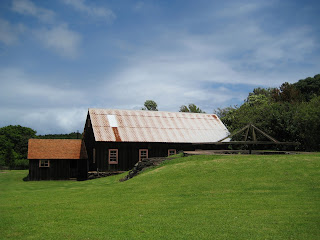At the age of twenty-four, Rudolph Wilhelm Meyer emigrated from Germany to Hawaiʻi where he arrived on January 20, 1850. At the time, Meyer listed his occupation as a surveyor.
His main purpose in leaving Germany was to join the “Gold Rush” to California in 1848, but he was delayed on a stopover in Sidney, Australia, and again in Tahiti, after which he landed at Lāhaina, Maui.
Meyer spoke German, French and English when he arrived in Hawaiʻi, and soon wrote and spoke fluent Hawaiian.
Meyer settled on Molokaʻi. There, he met the Reverend Harvey Rexford Hitchcock I, who accepted him as a house guest at Kaluaʻaha, Molokaʻi.
While living with Reverend Hitchcock, he met High Chiefess Kalama Waha, who later became his wife. Sometime later, he moved his family to Honolulu where he worked for Austin and Becker at an office located on Maunakea Street.
The Meyer family later moved back to Molokaʻi and made their permanent residence at Kalaʻe. They eventually had eleven children, six boys and five girls.
He supported his family, in part, by holding a number of local commissions from the Royal Hawaiian government, but primarily from his diverse agricultural activity.
Ranching began on Moloka‘i in the first half of the 19th-century when Kamehameha V set up a country estate on the island, part of which is now the Moloka‘i Ranch. Rudolph Meyer, one of the first western farmers on Moloka‘i, served as ranch manager for King Kamehameha V. (DLNR)
He planted at various times coffee, corn, wheat, oats, taro, potatoes, beets, cassava, peaches, mangoes, bananas and grapes. He was the first on Molokaʻi to grow, produce and mill sugar and coffee commercially and he exported these to Honolulu and California. He also operated a large dairy from which he produced butter.
Meyer started to grow sugar at the time when the 1876 Reciprocity Treaty between the United States and Hawaiʻi removed the tariff on Hawaiian sugar sold in the United States.
Rather than the expansion and innovation that followed the Treaty, Meyer scaled his mill to satisfy the modest 50- ton annual production from his family's 30-acres of sugar cane.
Constructed in the 1870s the RW Meyer Sugar Mill is one of the only sites in Hawaiʻi with sufficient material remains intact to demonstrate, fairly completely, a nineteenth-century process of sugar manufacture. The equipment included a mule-driven cane crusher, redwood evaporating pans and some copper clarifiers.
In the early-1880s, when the average investment in Hawaiʻi’s fifth-six sugar plantations exceeded $280,000, the Meyer family investment of $10,000 made their mill one of the smallest in Hawaiʻi.
Meyer adopted and followed mill practices more representative of the 1850s and the 1860s than the 1870s and 1880s. In the 1850s, animals powered the mill equipment; while he stuck with this method into the future, others replaced the animal power with steam and water.
The Meyer Sugar Mill easily accommodated the milling requirements of the family's sugar lands and repaid the investment within a few years; however, during the 1880s the price paid for sugar steadily declined.
The Planters' Monthly reported in July, 1887, that "Low prices of sugar still prevail...and many a man who once thought himself assured of reasonable wealth through sugar, now finds that it will not even yield him a competence...only running the sugar business on a large scale can it be made to pay."
In 1892, CM Hyde reported that the Meyer Mill stopped producing sugar cane when "The low price of the product for the last few years ... made it more than unprofitable to engage in sugar manufactured in a small way. Now the lands are given up to grazing."
Meyer also served as the Superintendent of the isolated Kalawao settlement (Kalaupapa) (serving with Father Damien and Mother Marianne Cope (now, both are Saints)) from 1866 till his death in 1897 (he continued to live with his family at the top of the cliffs, rather than on the Kalaupapa Peninsula.)
He also created one of the first trails used to travel between Kalaupapa Peninsula and the mauka lands. It was used to transport cattle and supplies down to Kalawao.
RW Meyer Ltd still owns property in the southwest corner of the Kalaupapa National Historical Park near the Kalaupapa Trailhead and maintains a Memorandum of Understanding (MOU) with the Park for trail access, maintenance and the planting of native plants.
The Meyer Mill has been restored and is operating as a museum. Lots of information here is from NPS and rwmeyer-com. The image shows the RW Meyer Sugar Mill. In addition, I have added other images in a folder of like name in the Photos section on my Facebook and Google+ pages.
Follow Peter T Young on Facebook
Follow Peter T Young on Google+
© 2013 Hoʻokuleana LLC

No comments:
Post a Comment